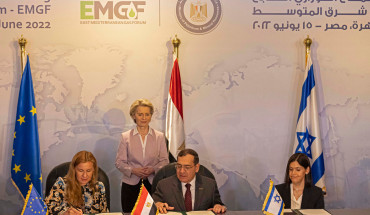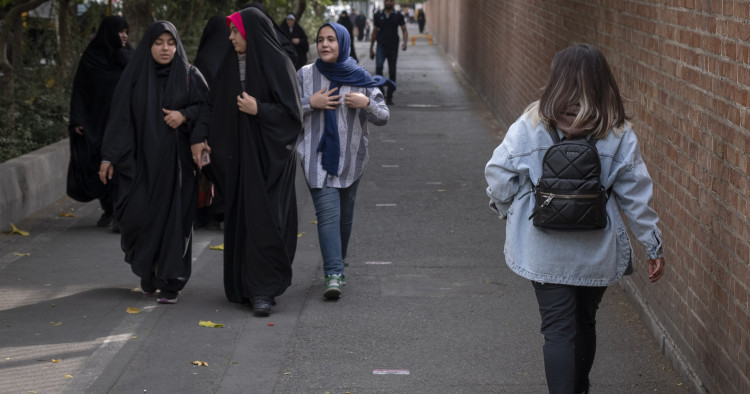In September 2022, urban centers across Iran reverberated with the sound of protest. The scale and uninhibited nature of these demonstrations against the repressive Islamic Republic were in and of themselves unprecedented, but another notable and particularly unique characteristic of the protests was the primary demographic of the protesters: women and youth. In the wake of Mahsa Jina Amini’s death, women and young Iranians in particular embodied the rage against the government, crying out for personal autonomy regarding their dress, self-expression, and faith. In turn, workers’ unions, ethnic and religious minorities, and other marginalized groups in Iran stood in solidarity with these demands, rallying behind the general notion that the manipulation of women’s rights would no longer be an acceptable facet of Iranian society: the phrase “Woman, Life, Freedom” thus stood at the core of their movement.
Since the height of the protests in 2022, the government cracked down with a new degree of severity on the protesters, reducing their numbers on the street. Over a year later, many activists and youths remain imprisoned, including Nobel laureate Narges Mohammadi, who was unable to attend the Dec. 10, 2023, ceremony for this fact. Additionally, on Nov. 23, 22-year-old Milad Zohrevand was the eighth person executed for taking part in the Mahsa Amini protests — a stark reminder of the regime’s willingness to use capital punishment against even young activists. The government of the Islamic Republic remains a major source of great disillusionment and ferocity for the youth, but their ability to fight back is highly limited at this stage. Many leave if they can. Those who stay have adopted less visible shows of political and social dissatisfaction against the regime’s aggression.
The critical role of Iran’s youth
Young people account for a sizable proportion of Iran’s 88 million-strong population, with around 60% of Iranians under the age of 30. This portion of Iranian society faces a future plagued by economic hardship, oppression, and inequality. Their grievances, coupled with younger Iranians’ greater digital proficiency and connectivity, contributed to the critical role youth played in the wave of dissent in 2022. Despite being largely well-educated, unemployment remains high among younger Iranians, with around 40% of females and 25% of males aged 14 to 25 out of work and not attending school. This fear and hopelessness about the future affects even those able to pursue a higher education: some of the most active protesters in 2022 were university students, who during the first two months after Mahsa Amini’s death, demonstrated at 143 universities spanning all 31 provinces.
At the same time, Iran’s youth has grown up in a political climate defined by a culture of protest and violent retributions by the state. After an increase in fuel prices led to demonstrations across Iran in November 2019, those protests — known as “Bloody Aban” — saw the deaths of roughly 1,500 protesters at the hands of the Islamic Republic’s security forces, including 17 teenagers. This event — in which protests were met with brutal suppression and the demands of protesters left unanswered — became one of several defining events that entered the collective memory of the current generation of young Iranians. It has thus been ingrained in the psyche of Iran’s youth that the Islamic Republic will not even spare the lives of young people in its relentless efforts to quell dissent and maintain its grip on power. This increasing evidence of the government’s apathy toward young people and unwillingness to entertain any reforms advocated by society, therefore, became further motivation to rally for the regime’s overthrow during the 2022 protests. The motivation stemmed from the desire to challenge the system and “raise questions about the legitimacy of the regime that claims to be God’s polity on Earth.”
In October 2022, Ali Fadavi, the commander of the Islamic Revolutionary Guard Corps (IRGC), said that the average age of those arrested during the protests was 15. Though he shared this information in a bid to blame the influence of foreign media, it demonstrated how strikingly young the protesters were for the impact they made. Furthermore, the head of the Intelligence Protection Organization of the IRGC, Sardar Majid Khademi, emphasized how the state’s “war with the enemy is a war to attract the youth,” further denoting the essential role of young Iranians.
The government’s response to the demonstrations of 2022 was, thus, telling: It included the use of live ammunition against demonstrators, mass arrests, and internet restrictions in a bid to destroy the spirit of resistance among Iran’s youth. Between September and December 2022, hundreds of protesters were killed, including at least 44 children. Furthermore, to combat the fierce online activism by young people and restrict their connectivity to the world, the Iranian authorities resorted to large-scale internet shutdowns and disruptions as well as filters on social media sites such as WhatsApp. In some cities, internet censorship has been particularly stringent and enduring — in Zahedan, the capital of Sistan and Baluchestan province, internet shutdowns have consistently occurred every Friday for over a year. Internet blackouts have been a tactic of the Islamic Republic since 2009, and protesters have found different means to try to stay online, including using virtual private networks (VPNs), encryption, and apps such as Telegram that remain relatively untouched. These innovative methods have allowed young Iranians to continue to communicate, mobilize online, and broadcast their cause to the world, despite the authorities’ attempts to silence them.
Youth participation one year on: Changes and continuities
One year on from the 2022 protests, the pushback is considerably more subdued. As widespread as the protests were, they lost their momentum by the beginning of 2023 as thousands of demonstrators faced violence and legal repercussions, ranging from lengthy detainment all the way to the death penalty. While Iranian youths have exhibited some of the bravest and most forthcoming forms of dissent, they also must now deal with the aftershocks in the form of mental health issues, grieving their peers, and coming to terms with the protest movement’s stagnation. Ultimately, the reason for this dip in resistance was that the youth-led movement lacked the leadership that would be necessary to substantially challenge or intimidate the government as well as withstand its repressive policies for the long term.
Contrary to the unprecedented and widespread uproar of September 2022, the approach of young protesters in the period following the one-year anniversary of Mahsa’s death has evolved, with Iran’s Generation Z presently favoring more discreet, though still high-risk, methods of challenging the regime and its values. In this new atmosphere of quiet defiance, it has become more commonplace to see Iranian women in public with their hair uncovered, risking arrest and imprisonment by the morality police, which continues to patrol the streets with renewed vigor. Night protests have become another preferred method for young Iranians, characterized by the playing of revolution-driven music in the streets and defacing government buildings with anti-regime posters and graffiti. These brave acts of civil disobedience continue to feed the flame of rebellion among Iran’s youth in the face of government brutality.
While an extensive security presence largely deterred any large-scale demonstrations on Sept. 16, 2023, young Iranians have nevertheless used the above-mentioned diverse, surreptitious methods to continue their fight. Recent reports offer some limited but suggestive evidence that underground youth groups are forging alliances and building networks across the country. Formed two years ago, the United Youth of Iran (UYI) is an alliance of underground youth groups connecting activists, workers’ associations, women’s rights groups, and student organizations. The umbrella group’s main goals are to organize protests, educate and prepare protesters, and minimize casualties. As expressed by a 19-year-old student from Isfahan in an interview with The Guardian, “If the regime successfully stops people all over the country from protesting on Mahsa’s death anniversary, we have many other ways to continue our protests. And we will.”
Prior to the crackdown at the turn of 2022/23, the UYI’s network reached over 35 cities across Iran; but after a series of members were arrested or killed, its size and reach have dwindled. It is therefore understandable why many are skeptical of the actual threat these covert resistance groups currently pose to the Islamic Republic, as activists are forced underground and their methods are severely limited by intense government monitoring and the risk of severe punishment. In an interview with Iran International, a UYI representative explained that the regime’s tactics against youth groups mainly entailed identifying and arresting members as well as “spreading rumors about [their] connection with dubious political groups.”
While 2022’s wave of dissent inspired rallies and demonstrations in solidarity around the world, some young people inside Iran are unconvinced that support from the diaspora and the international community is truly effective or devoid of selfish motives. It’s likely the failed opposition coalition last year contributed to that sense of disillusionment among young protesters, who often judge opposition efforts by the diaspora as too far-removed from the demands and realities of Iranians living inside Iran. As a young protester from Mashhad told Middle East Eye, “They who are safe outside of Iran can't even unite with each other; how do they want to save us from the devils of the Islamic Republic?”
The risks and consequences of participation
Regime change is easier said than done, and young Iranians, as well as their families, thoroughly understand the risks and consequences that come with participating in this anti-government movement. Unfortunately, many young people taking part in the protests faced fates not dissimilar to Mahsa; up to 80 minors have been killed by the state so far. The cost of engaging in the demonstrations often means severe violence, imprisonment, and death — outcomes that did not stop the youth in the early months of the protest movement but now encourage young people to think twice about such public activism as the situation has settled. Additionally, families have continued to be harassed and targeted by the state even in the aftermath of the deaths of their children, creating reluctance to allow younger relatives to head back to the streets.
The choice between activism versus the desire to avoid prison, or more extreme outcomes, has tilted substantially toward the latter because of stronger government crackdowns and threats. As the one-year anniversary of Mahsa’s death neared, the Islamic Republic ramped up its draconian suppression methods in several parts of the country, such as in the Kurdish regions, redeploying security personnel to areas that had largely not seen such a presence since the first protest wave. This resumption of intimidation tactics, including arbitrary arrests, detention, or violent quelling of peaceful gatherings adds further pressure on young people.
Even faced with such coercion, Iran’s younger generations have remained more open and ready to oppose the regime than their elders, particularly after having seen first hand the potential “transformational impact of collective action.” However, young Iranians also understand that reigniting the movement to the levels it reached a little over a year ago would invite further unabashed violence from the state. This past October, yet another young woman was hospitalized after falling into a coma following an altercation with the morality police. She later died from her injuries. State-affiliated media outlets have denied that the government-mandated hijab enforcers used any physical violence against her, though it is evident that 16-year-old Armita Geravand faced brutal repercussions for openly traveling on the Tehran metro without her head covered. Such continued ferocity raises questions and concerns about whether the efforts of the youth were or might ultimately be in vain.
That isn’t to say that there has been absolutely no change evident in some Iranian cities. A September Intelligencer article featuring interviews with young Iranians includes one 28-year-old male who makes the point that “if this movement was about [the] hijab, then it was definitely successful. But the movement said it was going to bring down the regime. It wasn’t successful at that.” Indeed, the government continues to effectively threaten students to lay low, forces them to declare their political and religious beliefs, has allegedly conducted chemical attacks in schools, and removes any professors friendly to the protest movement from educational institutions. At the same time, young people express fears that older and more conservative protesters will attempt to hijack their movement to, for example, push for a return to some nostalgic monarchical past.
State responses
A little over a year since angry Iranians took to the streets chanting, “Woman, life, freedom,” change can be observed in Iran; but it has been gradual, arduous, and precarious to maintain. Whereas any progress on the movement’s most ambitious goal, regime change, will require society to unite through ideology — a challenging feat that eludes activist movements in many Western countries. A unified political drive under the scope of a defined ideological framework would provide guidance for structuring a future system, rather than leaving room for a political vacuum. While underground movements and the defiance of the hijab have been encouraging, Iranian young people still feel immensely estranged from the state, and Iran faces a major threat of brain drain amid growing youth migration rates. Meanwhile, people are further exposed to stressors unrelated to this movement, such as significant economic hardship.
The Islamic Republic and regime-linked media outlets are aware that the youth are disillusioned, and, while rarely admitted publicly, this has apparently amplified anxiety among the leadership. Traces of this concern have come out in sparse comments by Iranian authorities regarding the most recent wave of demonstrations in the autumn of 2023. A member of the national security committee warned this past summer of the consequences of reinstating hijab patrols, citing the emigration of educated and professional groups as a negative outcome. In turn, religious figures in Iran have made statements beckoning “students and young people [to] know the methods of the enemy, who have no concern other than creating discord, and know the ways to deal with it.” By blaming foreign influence, the government continues to evade the gradually unfolding reality that the youths in Iran are no longer going to be complacent under this repressive system. Nonetheless, the state continues to insist upon religious propaganda, denial, and punishment as its modus operandi.
Conclusion
A representative of Supreme Leader Ayatollah Ali Khamenei warned in a recent speech that universities are vulnerable to the “enemy,” which will seek to make them “the first place where new riots should begin.” As his predecessor, Ayatollah Ruhollah Khomeini, once declared, universities are “more dangerous than cluster bombs” due to the young minds that inhabit them. And though such accusations of foreign meddling at Iranian universities owe in large part to the regime’s ideologically driven insularity and paranoia, the Islamic Republic’s leadership is right to worry about the collective sentiments and potential of Iranian students and the youth.
Networks of dissent continue to exist domestically; yet the consequences for taking action at this point have proven exceptionally high for Iran’s young activists. Greater international media coverage of these issues could help. Alternatively, some experts have argued that easing sanctions on Iran could permit a greater penetration of technology services, which would help discourage the country’s paranoid isolationist composure. The Islamic Republic’s hardliners are arguably the only ones who benefit from an exclusionary foreign policy and the maintenance of paralyzing economic sanctions. If the international community intends to provide relief for the rising generation of Iranians, it must be more intentional in handling Iran, ideally by doing a better job of designing policies whose effects differentiate between the totalitarian regime and the people living under such repression.
Undoubtedly, young Iranians will continue to be the critical engine capable of instilling lasting change. They are the most politically active youth group of all 57 nations of the Islamic world, posing a substantial threat to theocratic rule despite the deadly risks this carries for them. Members of Iran’s Gen Z, in particular, are exposed to and in many ways have internalized liberal values and priorities. As the regime has come to understand — and fear — these young Iranians strive to construct identities that explicitly lie beyond the restrictive nature of the Islamic Republic.
Henna Moussavi is an MPhil candidate in Modern Middle Eastern Studies at the University of Oxford. She is also the Editor-in-Chief of the Oxford Middle East Review. Her research regards contemporary Iranian political and social affairs.
Elnaz Sharifi is a recent graduate from the London School of Economics, where she obtained a BSc in Politics & International Relations and was the Middle East & North Africa correspondent for the London Globalist.
Photo by Morteza Nikoubazl/NurPhoto via Getty Images
The Middle East Institute (MEI) is an independent, non-partisan, non-for-profit, educational organization. It does not engage in advocacy and its scholars’ opinions are their own. MEI welcomes financial donations, but retains sole editorial control over its work and its publications reflect only the authors’ views. For a listing of MEI donors, please click here.













